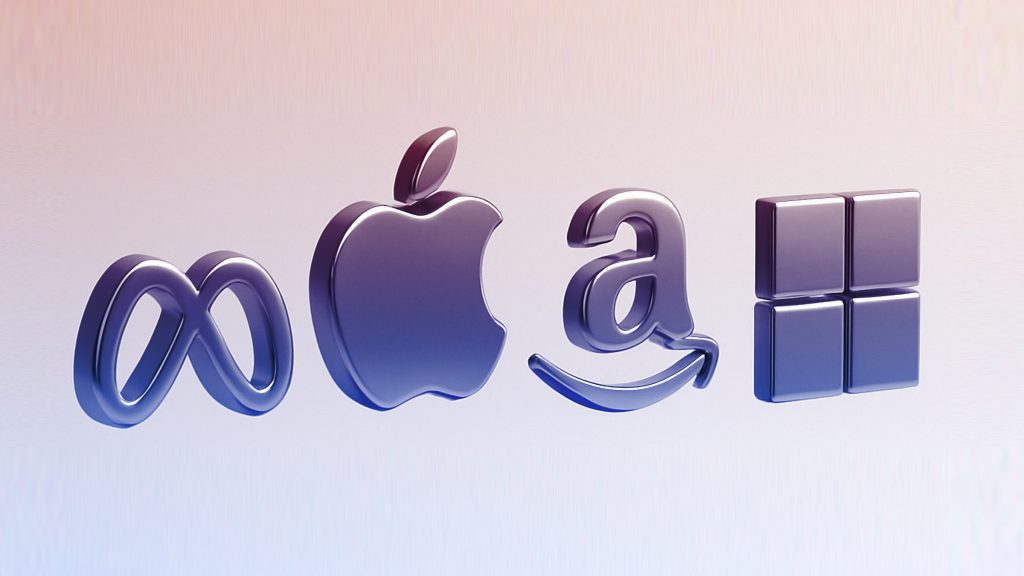
As global markets face mounting uncertainty from President Trump’s aggressive AI tariffs policies, Big Tech’s Meta, Amazon, Apple, and Microsoft are weathering the storm by doubling down on AI, turning economic anxiety into AI fueled profit.
While traditional industries support trade disruptions and rising costs, big tech AI investments are not just surviving they are thriving. AI is proving to be their shield and sword, driving revenue growth, improving efficiency, and protecting the impact of political and economic headwinds. As investors search for stability, the spotlight shifts to how Silicon Valley is using AI.
Microsoft, with its nearly $13 billion stake in OpenAI, has turned Azure into the backbone of enterprise AI. In Q2 2025, the company posted a 19% jump in cloud revenue, driven largely by AI demand.
“Every customer I speak with wants to adopt AI for productivity, security, and innovation,” said CEO Satya Nadella.
Microsoft’s Copilot is now integrated across Teams, Word, and Excel, redefining how businesses operate.
Meta has heightened its open-source LLaMA models to gain influence in AI research, but the real story is advertising. AI driven targeting helped boost Meta’s ad revenue by 25% year over year (YoY).
“We’ve had a strong quarter both in terms of our business and community,” said Meta CEO, Mark Zuckerberg.
Meta AI, its assistant, now lives across platforms even in smart glasses blending seamlessly into everyday life.
Amazon is using AI to optimize everything from logistics to cloud offerings. AWS saw a 17.5% rise in revenue, driven by demand for its generative AI products. The company’s e-commerce segment is also doing well, with AI enabling personalized buying and fulfilment optimization. Net sales spiked 13%, according to AFP, showing Amazon’s strength despite tariff pressures.
Apple, being more conservative in adopting new technology, splurged at WWDC 2025 with Apple Intelligence. Focused on privacy and local processing, its functions like Smart Recap and Genmoji are created with user control in mind. Though Apple lost $800 million to AI chip tariffs during the previous quarter, strong iPhone 17 sales 8% higher demonstrate heightened customer demand for AI-based devices.
President Trump Announces Reciprocal Tariffs Against Dozens of Nations
Since January, President Trump’s tariffs have pursued an agenda, launching sweeping tariffs aimed at reshaping global trade. The policy includes a 10% blanket tariff on all imports, plus higher rates for key countries, 145% on China, 50% on Brazil, 26% on India, and 25% on Canada and Mexico. Nations trading in Russian energy also face 100% secondary tariffs.
These Trump AI tariffs move brought in $87 billion in US AI tariff revenue by June but also unleashed a global backlash. Retaliatory tariffs from Canada, the EU, and China total over $160 billion, disrupting $330 billion in American exports and raising consumer prices by 3–5%.
The International Monetary Fund (IMF) warns these global trade disruptions actions could shave 0.5% off global GDP by 2027. Emerging economies like India face export declines of up to 3%. Meanwhile, Wall Street is showing signs of distress. The S&P 500 dropped 6%, the Nasdaq 16%, and tech firms saw billions in lost value.
Big Tech is still fighting back, but with their supply chains under pressure and manufacturing costs rising, they are betting even more heavily on AI to stay ahead. Big Tech tariffs may sting, but AI offers an escape hatch.
Big Tech Is Bad Big AI Will Be Worse
While tech giants gain money from AI integration, their smaller rivals are struggling to keep up. Big tech investment in AI increases have increased hardware costs, especially for those importing from Asia.
Add to that limited access to high performance computing, increasingly controlled by Big Tech after the Nvidia ai chip gold rush growth, and the innovation landscape begins to look imbalanced. Those are building conditions that are widening the gap between officeholders and disruptors, threatening the kind of disruptive innovation that once defined the tech industry.
As Big Tech dives deeper into AI gold rush stock, concerns are growing about merging, controlling, and long-term impacts. The risk? A future where a handful of corporation’s shape everything from speech to commerce perhaps through AI tariffs.
Inside Telecom provides you with an extensive list of content covering all aspects of the tech industry. Keep an eye on our Tech sections to stay informed and up-to-date with our daily articles.